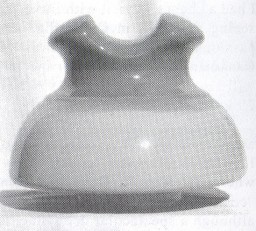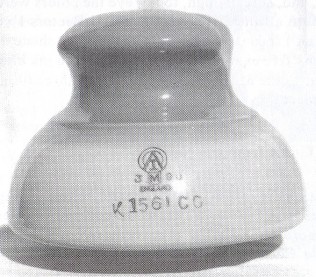Foreign Insulators
by Marilyn Albers
Reprinted from "Crown Jewels of the Wire", April 1996, page 6
READERS RESPOND TO
“THIS ONE’S AUTHENTIC, FOLKS!”
which appeared in the February, 1996 issue of Crown Jewels of the Wire. To
refresh your memory, take a look at both front and side views of the particular
U-2725 in question. Since that article was published, l have learned that the
‘M’ inside the square below the ‘AI ’ trademark means the pinhole has
metric threading. And, lengthy as it is, ‘K1561CC’ is the style designation.
I asked why all these letters and numbers were necessary and was told by David
Hibbert, one of the managers of British Telecom, that Allied Insulators has made
so many styles through the years that this was the only way they could keep them
all straight!


As promised, here are the responses from some of our knowledgeable readers:
February 10, 1996
Dear Marilyn,
As an owner of one of the U-2725 insulators, it is obvious that I considered
that these are legitimate collectible insulators. The question that has been
posed to me is if these should be considered private issues.
I believe that Allied made these with the intention that the insulators could
be used on distribution lines and the fact that they sit on collectors’
shelves is only secondary. These insulators are standard produced electrical wet
process porcelain. The blue top is a chloride-based matt glaze radio treatment
which has been experimented by a few American manufacturers, but is primarily
European in use. It is therefore practical rather than just pretty. It could be
placed in service easily and therefore was intended for much more than a
collectible dust catcher on the mantle.
Sincerely - best in collecting
Jimmy Burns, 81 Allendale, Conroe, TX 77302
P. S. You omitted the fact that these came with a paper electrical test label
which meant that these were standard tested at the plant to be placed in service
at a later date.
Yes I did, Jimmy, and thank you for reminding me of that!
Marilyn
February 21, 1996
Dear Marilyn,
As always, I enjoyed your February CJ column. I’m responding to your
request for comments regarding the U-2725, specifically: “Would you consider
the blue U-2725 a genuine collectible insulator?”
It seems that any object that develops interest and appeal in any circle of
collectors is considered a collectible. Remarkably, the term “collectible”
can also include such items as fakes, reproductions, commemoratives, etc. A good
example of this—with notable correlation to the U-2725—is the CD 155 Kerr in
clear with blue splotches. As you know, these “special issue” insulators
were manufactured at the Kerr plant in authentic molds. From their initial
distribution they were sold as an insulator specifically made for collectors.
They are now unquestionably established in the hobby as a “collectible”. My
real question of concern is not with the “collectible” issue, but rather:
Should they be accepted and classified as an authentic insulator?
It is my strong opinion that they should not. They were not produced for
actual field use. If I understand correctly, the U-2725 referred to in your
article also falls into this same category. I feel that any deviation from
original factory or user specifications (shape, color, size, etc.) should not be
labeled as genuine or authentic. I would prefer to see items of this type
referred to as “special issue” or “collector’s issue”.
My one primary concern is that the potential for profiting could cause the
practice of special factory orders to get out of hand. The possibility of
dishonesty could also become a frightening side effect. Nonetheless, if such
items are produced on a “special order” basis, it is important that that
fact be well documented within our hobby, as you have done in CJ regarding the
U-2725.
I could go on but I need to get this in the mail so you receive it by your
deadline. I hope my brief viewpoints are in some way helpful to you. I’d be
happy to discuss my thoughts further with you at any time if need be. As always
I’m looking forward to seeing you this summer (in Long Beach). If all goes
well, I plan to attend the Central Regional (in Houston)!
Your friend,
Dwayne Anthony 1066 Scenic Dr., San Bernardino, CA 92408
Leroy Neimi of Green Bay, Wisconsin, telephoned me with his opinion of the
U-2725. He was quite comfortable with my description of it as a “genuine
collectible insulator” and didn’t consider this piece to be in the same
class as the unembossed CD 631’s I wrote about in the August, 1995 issue of
Crown Jewels of the Wire. If readers will recall that article, a small glass
factory in England (whose production line had never before included insulators)
agreed to make several CD 631’s from a special mold designed by a British
collector. Because there is only one known and it’s locked up in a collection,
this fellow didn’t have a CD 631 from which to get the exact specifications,
but a scale drawing would not have been difficult to find and would have served
the purpose just as well! Soon realizing that there was no market for these
insulators in England, he sent me one of the “repro” CD 631’s and asked if
I would try to sell a few of them in America. I turned that offer down real fast
but did take the faux CD 631 to the NIA National Show in Marlborough,
Massachusetts, July 14-16, 1995 for the purpose of education.
Lu Farin of Decatur, Texas, expressed her views on the U-2725 by phone. She
felt that it shouldn’t make any difference whether the customer’s order was
large or small and that the size of it had nothing to do with authenticity. The
U-2725’s were made by an authentic insulator manufacturer who stamped their
official trademark on each of them and applied the blue glaze as requested. She
considers these blue insulators to be as authentic as any of the other styles
and/or colors the company offers.
In still another telephone conversation, Elton Gish of Buna, Texas, said he
had absolutely no qualms about the authenticity of the blue U-2725’s. He said
that any insulator manufacturer will take special orders and won’t question
what they are going to be used for. The very fact that the ‘AI’ trademark
appears on the insulators indicates that the company considered them to be
finished products intended for electrical service, no matter what color glaze
was applied. Allied Insulators is proud of their name and reputation and if they
had not considered these insulators to be authentic, they would never have added
their stamp of approval.
Many thanks to Jimmy, Dwayne, Leroy, Lu, and Elton for sharing their
thoughts. When all is said and done, the bottom line is education, education,
education!
| 